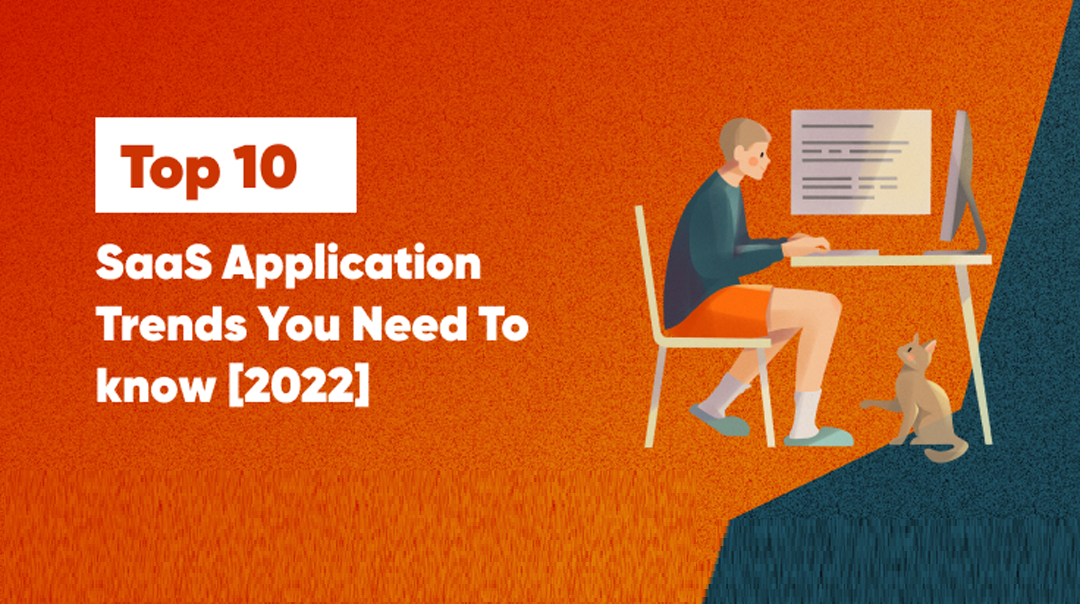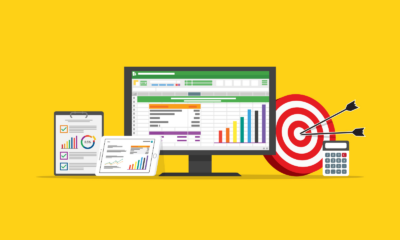MARKETING
Top 10 SaaS Application Trends You Need to know in 2022

Software as a service model has gained immense popularity in the past few years. It offers cutting-edge solutions in a wide range of industries. SaaS application development model provides a lot of cost-effectiveness and flexibility making it an amazing option for business models and industries. Currently, there is huge competition among SaaS products. As per the latest report by DevSquad, SaaS spending across companies of all sizes will reach $500 billion by 2023.
To gain a competitive edge SaaS application development companies are adopting modern technologies. In this blog, we will discuss the top 10 SaaS application trends you need to know in 2022. But before that, it is important to understand what is SaaS and how popular it is. So let’s get started.
Table of contents
◰ What is SaaS?
◰Some popular organizations that use SaaS
◰ Top 10 SaaS Application Trends
- Artificial Intelligence
- Machine learning
- Low code popularity
- Micro SaaS
- Vertical Saas
- SaaS analytics
- Focus on Mobile
- Migration to PaaS
- Data Security
- White labeling
◰ Conclusion
What is SaaS?
Saas or software as a service is a method of software delivery in which software is accessed through an online subscription rather than installed on individual computers. This process saves a lot of time spent on installation and maintenance. It allows us to access applications from anywhere and anytime using the internet. Some of the significant advantages of using SaaS are enhanced scalability, highly cost-effective, time-saving, fosters high security, and a lot more.
SaaS is used by top organizations like Salesforce, Zoom, Slack, GSuite, Hubspot, Shopify, and Netflix. As per the latest reports by DevSquad 80% of the businesses plan to make all their systems SaaS by 2025. Software as a service has a really promising future and it will continue to grow further. So till now, you have got a clear idea about SaaS now let’s move to the next section and discuss the top 10 SaaS application trends in 2022.
Top 10 SaaS Application Trends
Now we have explored the key characteristics of Software as a service. Now is the time to dive deeper into the top ten SaaS application trends. So let’s get started.
- Artificial Intelligence: Artificial intelligence is deep-rooted in the veins of our society. As per the latest reports by Gartner that customer satisfaction is expected to grow by 25% by 2023 in an organization that uses Artificial Intelligence. AI innovations will empower organizations across industries to gain deeper insights and understand the needs of their audience. So Artificial Intelligence will boom the SaaS landscape in a variety of ways, enhancing the key characteristics of the SaaS development model across the globe. When AI is combined with SaaS it helps to obtain better value from customers, automate services and enhance security.
- Machine learning: The second forecast for SaaS application trends in 2022 is Machine learning. Machine learning is a subset of Artificial intelligence that is used to automate responsiveness in applications. The latest innovations in ML will empower businesses to automate significant parts of internal operations. It will improve internal collaboration through more sophisticated models. Machine learning is currently one of the fastest growing segments and a hot SaaS trend for 2022.
- Low code or no code: It is another big evolution in the software industry. These platforms put complex application development in an almost finished state. Applications that can be developed using low code frameworks vary from simple mobile applications to complex enterprise applications. It is an excellent SaaS solution for developers as they can use their unique code with drag-and-drop functions to build applications.
- Micro SaaS: Micro SaaS products just focus on one type of service offered by service providers. It can be software, an extension, a bill payment system, or anything just focusing on one solution. These smaller tools can be easily managed at a low cost. With reduced cost, the profits will increase as work will be done at a lesser price. It has helped small tech industries in product development without any errors. That has led to the growth of these companies in the long run.
- Vertical Saas: The fifth forecast in SaaS trends for 2022 is Vertical SaaS. It is customizable and targets customers within a specific niche. Organizations that are looking for specific customizations will find vertical-SaaS to be a very cost-effective option. It provides amazing benefits like enhancing business value, improving data governance, and helping to explore new niches.
- SaaS analytics: It is the process used by industries to analyze user experience across all touch points. The analysis is used to increase customer engagement and enhance their revenue. SaaS analytics tools help you to fully understand the customer experience.
- Focus on Mobile: As per the latest reports, 83.37% of people have smartphones today which accounts for 6.64 billion smartphone users in the world. This clearly manifests that mobile is promised land for SaaS development. Business owners are increasingly running their businesses from smartphones. Therefore, SaaS companies need to create and improve mobile applications for services and tools.
- Migration to PaaS: PaaS stands for the platform as a service. Another fascinating SaaS trend that we can expect in 2022 is SaaS migrates further toward PaaS which empowers businesses to build custom applications. The advantages of using PaaS have enhanced scalability, security, and agility. With organizations like Salesforce and Box migrating towards PaaS we can expect to see this trend gaining more and more popularity in the coming years.
- Data Security: Data breach is one of the biggest issues that companies are facing in today’s era. Due to the increased use of the internet, hacking into someone’s system is really easy. Data security is really crucial and companies are willing to pay a huge sum for their security. As per the reports by Fortune Business Insights the global information security market is expected to reach $366.1 billion in 2028. So SaaS development companies can create SaaS products that are aware of online threads and find a solution to overcome those issues. It will be quite challenging but it is one industry where these products will thrive more.
- White labeling: Another forecast in SaaS trends for 2022 is white-label SaaS products. These products are designed to have no branding when sold to clients. The clients can further add branding to resell it to the customers. It is great for businesses that can easily sell products but lack the technical skills to build them. Another advantage of using a white-label SaaS is that businesses don’t have to invest heavily in the beginning. This makes white quite appealing to small businesses.
Conclusion
These 10 trends mentioned above will shape the SaaS landscape in 2022. Many developments have evolved in past years paving the way for new concepts that will take the industries to new heights. These concepts will transform the face of business intelligence in the coming years. These SaaS development industry trends will promise a progressive future for the country. SaaS options are now regarded as really affordable and convenient options across industries. As these digital transformations will grow globally the SaaS development industry will get stronger which provides a smarter and simpler future for all. I hope that you found this helpful!!
MARKETING
Google’s Surgical Strike on Reputation Abuse

These aren’t easy questions. On the one hand, many of these sites do clearly fit Google’s warning and were using their authority and reputation to rank content that is low-relevance to the main site and its visitors. With any punitive action, though, the problem is that the sites ranking below the penalized sites may not be of any higher quality. Is USA Today’s coupon section less useful than the dedicated coupon sites that will take its place from the perspective of searchers? Probably not, especially since the data comes from similar sources.
There is a legitimate question of trust here — searchers are more likely to trust this content if it’s attached to a major brand. If a site is hosting third-party content, such as a coupon marketplace, then they’re essentially lending their brand and credibility to content that they haven’t vetted. This could be seen as an abuse of trust.
In Google’s eyes, I suspect the problem is that this tactic has just spread too far, and they couldn’t continue to ignore it. Unfortunately for the sites that were hit, the penalties were severe and wiped out impacted content. Regardless of how we feel about the outcome, this was not an empty threat, and SEOs need to take Google’s new guidelines seriously.
MARKETING
18 Events and Conferences for Black Entrepreneurs in 2024

Welcome to Breaking the Blueprint — a blog series that dives into the unique business challenges and opportunities of underrepresented business owners and entrepreneurs. Learn how they’ve grown or scaled their businesses, explored entrepreneurial ventures within their companies, or created side hustles, and how their stories can inspire and inform your own success.
It can feel isolating if you’re the only one in the room who looks like you.
MARKETING
IAB Podcast Upfront highlights rebounding audiences and increased innovation


Podcasts are bouncing back from last year’s slowdown with digital audio publishers, tech partners and brands innovating to build deep relationships with listeners.
At the IAB Podcast Upfront in New York this week, hit shows and successful brand placements were lauded. In addition to the excitement generated by stars like Jon Stewart and Charlamagne tha God, the numbers gauging the industry also showed promise.
U.S. podcast revenue is expected to grow 12% to reach $2 billion — up from 5% growth last year — according to a new IAB/PwC study. Podcasts are projected to reach $2.6 billion by 2026.
The growth is fueled by engaging content and the ability to measure its impact. Adtech is stepping in to measure, prove return on spend and manage brand safety in gripping, sometimes contentious, environments.
“As audio continues to evolve and gain traction, you can expect to hear new innovations around data, measurement, attribution and, crucially, about the ability to assess podcasting’s contribution to KPIs in comparison to other channels in the media mix,” said IAB CEO David Cohen, in his opening remarks.
Comedy and sports leading the way
Podcasting’s slowed growth in 2023 was indicative of lower ad budgets overall as advertisers braced for economic headwinds, according to Matt Shapo, director, Media Center for IAB, in his keynote. The drought is largely over. Data from media analytics firm Guideline found podcast gross media spend up 21.7% in Q1 2024 over Q1 2023. Monthly U.S. podcast listeners now number 135 million, averaging 8.3 podcast episodes per week, according to Edison Research.
Comedy overtook sports and news to become the top podcast category, according to the new IAB report, “U.S. Podcast Advertising Revenue Study: 2023 Revenue & 2024-2026 Growth Projects.” Comedy podcasts gained nearly 300 new advertisers in Q4 2023.
Sports defended second place among popular genres in the report. Announcements from the stage largely followed these preferences.
Jon Stewart, who recently returned to “The Daily Show” to host Mondays, announced a new podcast, “The Weekly Show with Jon Stewart,” via video message at the Upfront. The podcast will start next month and is part of Paramount Audio’s roster, which has a strong sports lineup thanks to its association with CBS Sports.
Reaching underserved groups and tastes
IHeartMedia toasted its partnership with radio and TV host Charlamagne tha God. Charlamagne’s The Black Effect is the largest podcast network in the U.S. for and by black creators. Comedian Jess Hilarious spoke about becoming the newest co-host of the long-running “The Breakfast Club” earlier this year, and doing it while pregnant.
The company also announced a new partnership with Hello Sunshine, a media company founded by Oscar-winner Reese Witherspoon. One resulting podcast, “The Bright Side,” is hosted by journalists Danielle Robay and Simone Boyce. The inspiration for the show was to tell positive stories as a counterweight to negativity in the culture.
With such a large population listening to podcasts, advertisers can now benefit from reaching specific groups catered to by fine-tuned creators and topics. As the top U.S. audio network, iHeartMedia touted its reach of 276 million broadcast listeners.
Connecting advertisers with the right audience
Through its acquisition of technology, including audio adtech company Triton Digital in 2021, as well as data partnerships, iHeartMedia claims a targetable audience of 34 million podcast listeners through its podcast network, and a broader audio audience of 226 million for advertisers, using first- and third-party data.
“A more diverse audience is tuning in, creating more opportunities for more genres to reach consumers — from true crime to business to history to science and culture, there is content for everyone,” Cohen said.
The IAB study found that the top individual advertiser categories in 2023 were Arts, Entertainment and Media (14%), Financial Services (13%), CPG (12%) and Retail (11%). The largest segment of advertisers was Other (27%), which means many podcast advertisers have distinct products and services and are looking to connect with similarly personalized content.
Acast, the top global podcast network, founded in Stockholm a decade ago, boasts 125,000 shows and 400 million monthly listeners. The company acquired podcast database Podchaser in 2022 to gain insights on 4.5 million podcasts (at the time) with over 1.7 billion data points.
Measurement and brand safety
Technology is catching up to the sheer volume of content in the digital audio space. Measurement company Adelaide developed its standard unit of attention, the AU, to predict how effective ad placements will be in an “apples to apples” way across channels. This method is used by The Coca-Cola Company, NBA and AB InBev, among other big advertisers.
In a study with National Public Media, which includes NPR radio and popular podcasts like the “Tiny Desk” concert series, Adelaide found that NPR, on average, scored 10% higher than Adelaide’s Podcast AU Benchmarks, correlating to full-funnel outcomes. NPR listeners weren’t just clicking through to advertisers’ sites, they were considering making a purchase.
Advertisers can also get deep insights on ad effectiveness through Wondery’s premium podcasts — the company was acquired by Amazon in 2020. Ads on its podcasts can now be managed through the Amazon DSP, and measurement of purchases resulting from ads will soon be available.
The podcast landscape is growing rapidly, and advertisers are understandably concerned about involving their brands with potentially controversial content. AI company Seekr develops large language models (LLMs) to analyze online content, including the context around what’s being said on a podcast. It offers a civility rating that determines if a podcast mentioning “shootings,” for instance, is speaking responsibly and civilly about the topic. In doing so, Seekr adds a layer of confidence for advertisers who would otherwise pass over an opportunity to reach an engaged audience on a topic that means a lot to them. Seekr recently partnered with ad agency Oxford Road to bring more confidence to clients.
“When we move beyond the top 100 podcasts, it becomes infinitely more challenging for these long tails of podcasts to be discovered and monetized,” said Pat LaCroix, EVP, strategic partnerships at Seekr. “Media has a trust problem. We’re living in a time of content fragmentation, political polarization and misinformation. This is all leading to a complex and challenging environment for brands to navigate, especially in a channel where brand safety tools have been in the infancy stage.”
Dig deeper: 10 top marketing podcasts for 2024
-

 PPC6 days ago
PPC6 days agoHow the TikTok Algorithm Works in 2024 (+9 Ways to Go Viral)
-

 SEO5 days ago
SEO5 days agoHow to Use Keywords for SEO: The Complete Beginner’s Guide
-

 MARKETING6 days ago
MARKETING6 days agoHow To Protect Your People and Brand
-

 MARKETING4 days ago
MARKETING4 days agoAdvertising on Hulu: Ad Formats, Examples & Tips
-

 MARKETING5 days ago
MARKETING5 days agoUpdates to data build service for better developer experiences
-

 MARKETING5 days ago
MARKETING5 days agoThe Ultimate Guide to Email Marketing
-

 WORDPRESS4 days ago
WORDPRESS4 days agoBest WordPress Plugins of All Time: Updated List for 2024
-

 SEO7 days ago
SEO7 days agoAutomate Multi-Site Reporting With Google Sheets And GSC API
















You must be logged in to post a comment Login